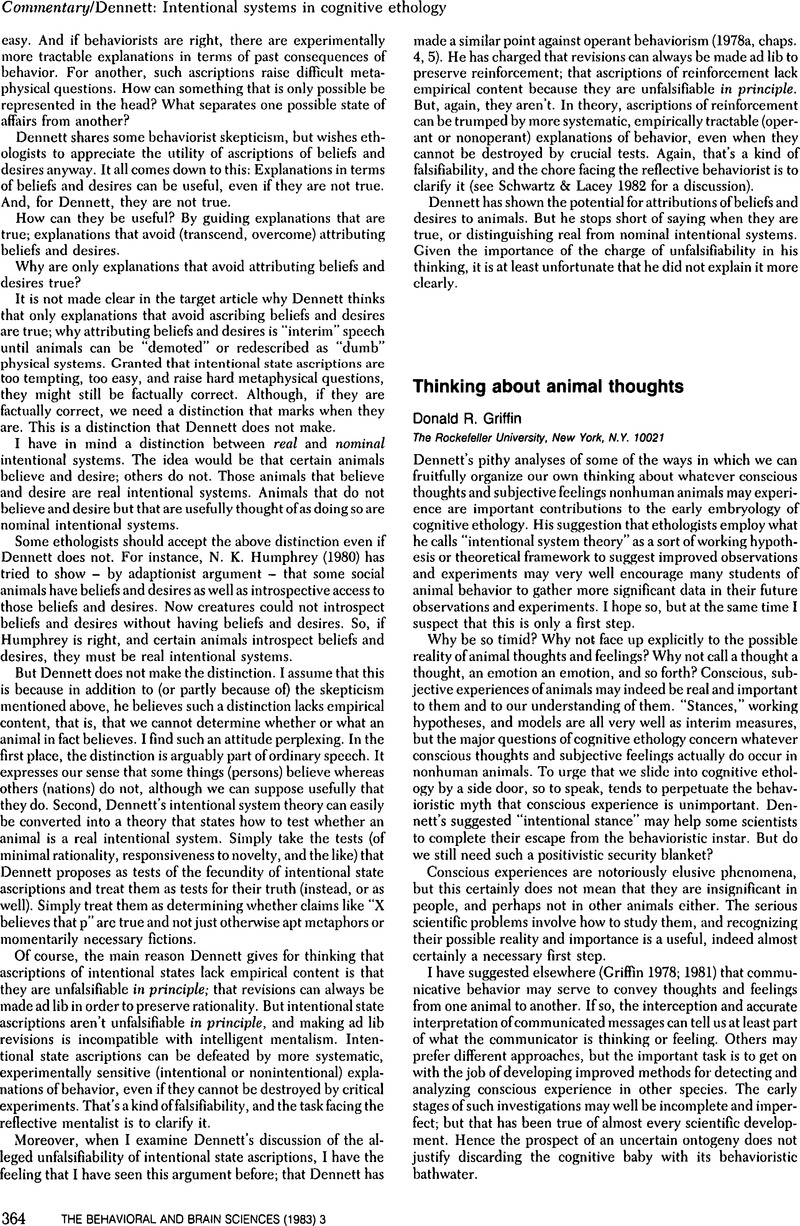Crossref Citations
This article has been cited by the following publications. This list is generated based on data provided by Crossref.
Latto, Richard
1986.
The Question of Animal Consciousness.
The Psychological Record,
Vol. 36,
Issue. 3,
p.
309.
Sloman, Aaron
1988.
Why philosophers should be designers.
Behavioral and Brain Sciences,
Vol. 11,
Issue. 03,
p.
529.
Cheney, Dorothy
and
Seyfarth, Robert
1988.
Another “Just So” story: How the leopardguarders spot.
Behavioral and Brain Sciences,
Vol. 11,
Issue. 03,
p.
506.
Smith, M. P.
1988.
Styles of computational representation.
Behavioral and Brain Sciences,
Vol. 11,
Issue. 03,
p.
530.
Searle, John R.
1988.
The realistic stance.
Behavioral and Brain Sciences,
Vol. 11,
Issue. 03,
p.
527.
Premack, David
1988.
Intentionality: How to tell Mae West from a crocodile.
Behavioral and Brain Sciences,
Vol. 11,
Issue. 03,
p.
522.
Amundson, Ron
1988.
Logical adaptationism.
Behavioral and Brain Sciences,
Vol. 11,
Issue. 03,
p.
505.
Roitblat, H. L.
1988.
How to build a mind.
Behavioral and Brain Sciences,
Vol. 11,
Issue. 03,
p.
525.
Cussins, Adrian
1988.
Dennett's realisation theory of the relation between folk and scientific psychology.
Behavioral and Brain Sciences,
Vol. 11,
Issue. 03,
p.
508.
Dennett, Daniel C.
1988.
Science, philosophy, and interpretation.
Behavioral and Brain Sciences,
Vol. 11,
Issue. 03,
p.
535.
Stich, Stephen P.
1988.
Connectionism, Realism, and realism.
Behavioral and Brain Sciences,
Vol. 11,
Issue. 03,
p.
531.
Rosenberg, Alexander
1988.
Will the argument for abstracta please stand up?.
Behavioral and Brain Sciences,
Vol. 11,
Issue. 03,
p.
526.
Churchland, Paul M.
1988.
The ontological status of intentional states: Nailing folk psychology to its perch.
Behavioral and Brain Sciences,
Vol. 11,
Issue. 03,
p.
507.
Lycan, William G.
1988.
Dennett's instrumentalism.
Behavioral and Brain Sciences,
Vol. 11,
Issue. 03,
p.
518.
Van Kleeck, Michael H.
1988.
Intentional system theory and experimental psychology.
Behavioral and Brain Sciences,
Vol. 11,
Issue. 03,
p.
533.
Taylor, Charles
1988.
What really matters.
Behavioral and Brain Sciences,
Vol. 11,
Issue. 03,
p.
532.
Griffin, Donald R.
1988.
Real intentions?.
Behavioral and Brain Sciences,
Vol. 11,
Issue. 03,
p.
514.
Newell, Allen
1988.
The intentional stance and the knowledge level.
Behavioral and Brain Sciences,
Vol. 11,
Issue. 03,
p.
520.
MacLennan, Bruce J.
1988.
Causes and intentions.
Behavioral and Brain Sciences,
Vol. 11,
Issue. 03,
p.
519.
Kitcher, Patricia
and
Kitcher, Philip
1988.
The devil, the details, and Dr. Dennett.
Behavioral and Brain Sciences,
Vol. 11,
Issue. 03,
p.
517.



